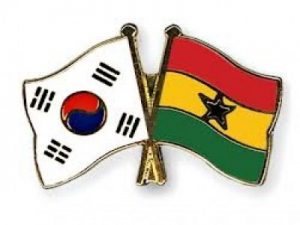History reminds us that at some point, African countries shared the bottom of the development league table with some of the world’s most developed countries today. A popular case study often referred to is that of Ghana and South Korea. In 2017, H.E. Nana Akuffo-Addo’s speech at a joint conference with the French president, Emmanuel Macron went viral. The speech was daring and passionate, and some might even say ruffled a few French feathers. The crux of his message was that African countries should by now, be able to stand on their own feet without being aid-dependent. In his address, he also made reference to how countries like South Korea were able to transition from being just as poor as African countries to becoming wealthy nations. He asked “What happened? Why did they make that transition? Why are we where we are? In this article, I intend to share some valuable lessons Ghana and other African countries can glean from South Korea’s ‘development miracle’.
In 1957, Ghana was the richest Sub-Saharan country based on per capita income standards. We enjoyed a per capita income of $490 as compared to $491 for South Korea. Ghana started its path of independence with a strong foot ahead. Our cocoa exports were booming at a rate higher than any other country in the world and we also exported as much as 10% of the world’s gold. Diamonds, bauxite, manganese, and mahogany were also strong commodities in our export portfolio and we owned reserves of more than $532 million. Something that many would deem an unbelievable tale today was the fact our liquid assets were seven times larger than our long-term debt and we were considered as one of the countries to have the best infrastructure in Africa. In today’s popular axiom, one would say ‘the system was working’ back then.
There are several explanations for why Ghana has retrogressed since then but that is not what I intend to unpack in this article. There is no world-acclaimed formula for how a country escapes the pit of poverty into the palace of prominence. However, the success of developed countries always leaves clues behind which if applied in the context of less developed countries, could be the game-changer.
The Quandary of Structural Transformation
One key element of structural transformation in most developed countries is industrialization. The shift from an agrarian economy to an industrial one has been modeled by developed economies, starting from Great Britain to the United States, then to Europe, and eventually the East Asian Tigers. O’Brien (2015) defines industrialization as a ‘rapid transformation in the significance of manufacturing in relation to all other forms of production and work undertaken within national or regional economies’. Industrialization may sometimes be naively associated with only building large factories to encourage value addition to raw materials but in this age of globalization, it will take more than building factories to create sustainable economic growth. Africa is a latecomer to industrialization and many argue that it is even more difficult to industrialize now given the many constraints of globalization. Technologies of developed countries are far advanced than that of developing nations, they have a substantial allocation for research and development, and restrictions set out by bodies such as the World Trade Organization with ‘universal’ oversight are even more stringent now than they were in the past. But being late to the party doesn’t mean we still can’t have a good time.
In Jong-Dae Park’s book; Reinventing Africa’s Development, he proposes that sustainable development in the African context can be achieved when our competitive advantage(s) are matched with industrialization. Africa has at its disposal two competitive advantages; arable land and a young population. Dr. Akinwumi Adesina, the President of the African Development Bank has continuously pitched Africa as the world’s hope for feeding 9 billion people by 2050, stating that Africa has 65% of the world’s uncultivated land. According to the World Bank, as at 2018, 20.7% of Ghana’s total land share was categorized as arable while only about 14% of Korea’s land was considered in a similar state. Again, Ghana’s land size is twice as large as Korea’s. However, there is a significant gap between both countries in food importation despite the former having more arable land. See Figure 1 below. This reaffirms the fact which Dr. Adesina is quick to note, that it will take the mechanization and modernization of agriculture, adopting technology, investing in the relevant infrastructure, and the support of robust policy to turn around the fortunes of agriculture in Africa.
Korea could be considered a latecomer at the time of its entry into industrialization because there were already existing players. However, they were able to identify the gaps in the local and international market and adapted accordingly. As I hinted before, it takes unconventional thinking to be able to penetrate a global market that already has well-established players. For Korea, that sometimes meant defying the advice of the big shots like the World Bank to pursue strategies they were confident would work for them. Werlin (1994) notes this when he discusses how Korea decided to move from light to heavy industry strategy.
African countries will have to go beyond the bare minimum. Unconventional thinking means being able to leverage the gains from synergistic interactions between different parts of our economies and creating a niche for ourselves. As Youn-Suk (1997) argues, Korea cemented its step in the export market by not only restructuring and selecting targeted industries but also improving on existing products by redesigning, restyling, and adding extra amenities to suit market taste. All these advancements were made on the back of increased access to technical and vocational training as pointed out by Suh and Chen (2007), clearly highlighting the importance of the knowledge economy in supporting Korea’s structural transformation.

The picture is a bit more gloomy when it comes to manufacturing. According to Nomfundo and Odhiambo (2017), between 1995 and 2014, manufactured goods constituted an average of about 65.9% of Ghana’s total imports. The call for industrialization cannot be overemphasized, especially one that is championed in conjunction with agriculture. It is imperative that initiatives like the One District One Factory (1D1F) that seek to bridge the gap between agriculture and industrialization receive bipartisan support and do not become another victim of political squabbles. Jong-Dae suggests that ‘The ideal for developing countries would be to push for agricultural- rural sector development and industrialization at the same time in a way that results in these two producing mutually reinforcing effects’.
Proper Sharing of the National Cake
The Oxfam figures on inequality in Ghana are staggering. According to Oxfam, just one of the richest men in Ghana earns more in a month than one of the poorest women could earn in 1,000 years. They further argue that while the wealthiest 10% of Ghanaians share 32% of Ghana’s total consumption, the bottom 60% of the population consumes much less. If you are within the bottom 10%, you only consume 2%. On education, the Northern Region is the most marginalized with as much as a third of the poorest children who have never been to school, compared to just 5% of the wealthiest. Economic growth which is not inclusive sets a country two steps back after it takes a step forward. One of the lessons Ghana can pick from South Korea is the need to develop inclusive policies that take everyone along on the journey to the promised land. That is, development that is firmly rooted in the spirit of leaving no one behind.
In the 1970s, Korea adopted what they called the Saemaul Undong (SMU) – New Village Movement, a community development model mainly aimed at empowering rural areas and lifting them out of poverty. It was a reform that was not dependent on foreign aid always coming to the rescue. Ghana is not oblivious to the establishment of rural development programs. We have had the Northern Rural Growth Programme (NGRP) implemented by the Ministry of Food and Agriculture between 2007 and 2016 which had many success stories recorded despite the challenges it faced. In terms of poverty, the government has employed direct poverty reduction interventions such as the Livelihood Empowerment Against Poverty (LEAP) program. Despite the strides made, the impact of these initiatives and others are yet to move the needle on inequality between the Northern and Southern regions of Ghana. Figure 2 paints a clearer picture. SMU was a National movement that was inclusive right from the start. The Korean government decided to engage all 34,665 rural communities and further down, ensured that even at the grassroots, welfare was proportionally enjoyed by community members.
Figure 2: Poverty Head Count by Region
| REGION | POVERTY HEAD COUNT | POVERTY HEAD COUNT | POVERTY HEAD COUNT | % DECLINE BY 2013 FROM 1992 |
| 1991/1992 | 1998/1999 | 2012/2013 | ||
| ACCRA | 25.8 | 5.2 | 5.6 | -78.29 |
| ASHANTI | 41.2 | 27.7 | 14.8 | -46.57 |
| BRONG AHAFO | 65 | 35.8 | 27.9 | -22.07 |
| CENTRAL | 44.3 | 48.4 | 18.8 | -61.16 |
| EASTERN | 48 | 43.7 | 21.7 | -50.34 |
| NORTHERN | 63.4 | 69.2 | 50.4 | -27.17 |
| UPPER EAST | 66.9 | 88.2 | 44.4 | -49.66 |
| UPPER WEST | 88.4 | 83.9 | 70.7 | -15.73 |
| VOLTA | 57 | 37.7 | 33.8 | -10.34 |
| WESTERN | 59.6 | 27.3 | 20.9 | -23.44 |
Source: Ghana Statistical Service (2015), Al-Hassan and Diao (2007) and Author’s calculation
As Ghana embarks on an industrialization drive, it is important that the policies and strategies we implement do not further deepen the income disparities between the urban and rural living areas. Development projects and foreign direct investment should not only be prioritized in major cities like Accra and Kumasi or we will have to face the consequences. In 2003, after Nigeria embarked on its National Economic Empowerment and Development Strategy (NEEDS) as a tool for poverty alleviation, wealth creation, and employment, the program was rated by the UNDP’s Human Development Report as “very poor and lacking in accountability and equity.” Ghana has to learn its lessons from the failure of its neighbors. An industrialization drive will not automatically lead to an increase in household incomes for citizens in the low-income groups if we are not intentional about policy and implementation.
According to the World Bank, Korea recorded a GDP per capita of $31,846 in 2019. This compares to Ghana’s $2202 in the same year. This gives us an indication of how far we have to go as we strive for economic growth and development. This article is not a call to imitate Korea’s strategy in Ghana. I acknowledge the individual differences in both economies but we cannot continue to offer excuses for our delay. As our President boldly said to the French President, “…our main responsibility as leaders and citizens is what we need to do to grow our own countries. Our concern should be with what we need to do in this 21st century to move Africa away from being cap in hand and begging for aid, charity, and handouts”. The ball is in our court.
The writer is a Development Economist in training, a poet and story teller with pockets of experience in diverse industries and sectors; Insurance, Higher Education, Renewable Energy and Finance. Currently serves as the Postgraduate Officer at the University of Manchester Students Union where he advocates for various concerns of the student body. He also sits on the University’s Board of Governors.
Email: [email protected]
Linkedin: Nana Fredua Agyeman











